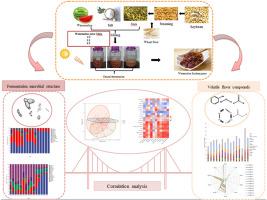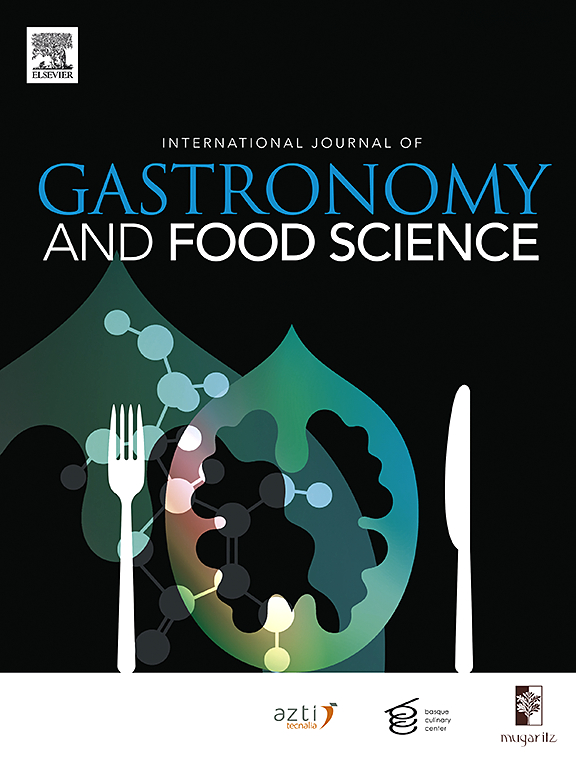发酵过程中添加不同西瓜汁的西瓜姜中细菌演替和风味成分的综合分析
IF 3.2
2区 农林科学
Q2 FOOD SCIENCE & TECHNOLOGY
International Journal of Gastronomy and Food Science
Pub Date : 2024-11-07
DOI:10.1016/j.ijgfs.2024.101053
引用次数: 0
摘要
本研究调查了在发酵过程中使用不同比例的西瓜汁和麴制备的西瓜大豆酱(WSP)中的理化因素、细菌群落和挥发性芳香成分。结果表明,高浓度西瓜汁能显著提高氨基酸态氮、还原糖和游离氨基酸的含量,但降低了细菌的多样性。在 WSP 样品中,发现肠球菌、芽孢杆菌、肠杆菌、葡萄球菌、木薯球菌、乳酸杆菌和魏氏菌是优势菌属,而在 WSP-4 样品中,肠球菌和木薯球菌占 50%以上。本研究在 WSP 样品中鉴定出 142 种挥发性成分,与 WSP-2 和 WSP-3 样品相比,WSP-4 样品中的挥发性成分浓度更高,尤其是吡嗪类。此外,电子鼻检测结果表明,西瓜汁对 WSP 样品香气成分的影响主要集中在发酵后期,但在整个发酵期间,无论西瓜汁浓度如何,所有 WSP 样品的香气特征都比较相似。因此,本研究发现,控制西瓜汁的用量和发酵时间能在一定程度上影响西瓜汁样品的香气特征,提高工业生产和食品质量。本文章由计算机程序翻译,如有差异,请以英文原文为准。

Comprehensive analysis of bacterial succession and flavor components in Xiguajiang with different watermelon juice supplementation during fermentation
This study investigated the physicochemical factors, bacterial communities, and volatile aromatic components in watermelon soybean pastes (WSP) prepared with different ratios of different watermelon juice to koji during the fermentation process. The results indicated that high concentration of watermelon juice could significantly increase the contents of amino acid nitrogen, reducing sugar, and free amino acids, but decreased bacterial diversity. Enterococcus, Bacillus, Enterobacter, Staphylococcus, Pediococcus, Lactobacillus, and Weissella were identified as the dominant genus bacteria in WSP samples, while Enterococcus and Pediococcus were found to account for more than 50% in WSP-4 samples. In WSP samples, this study identified 142 volatile components, the concentration of volatile components was more abundant in WSP-4 samples compared to WSP-2 and WSP-3 samples, especially in the pyrazine family. Furthermore, E-nose results showed that the influence of watermelon juice on the aroma components of WSP samples was mainly focused on the late fermentation periods, but aroma profiles were relatively similar in all WSP samples regardless of watermelon juice concentration throughout the fermentation period. Therefore, this study discovered that controlling the amount of watermelon juice and fermentation time can affect the aroma profiles of WSP samples to a certain extent, and improve the industrial production and food quality.
求助全文
通过发布文献求助,成功后即可免费获取论文全文。
去求助
来源期刊

International Journal of Gastronomy and Food Science
Social Sciences-Cultural Studies
CiteScore
5.30
自引率
10.50%
发文量
170
审稿时长
45 days
期刊介绍:
International Journal of Gastronomy and Food Science is a peer-reviewed journal that explicitly focuses on the interface of food science and gastronomy. Articles focusing only on food science will not be considered. This journal equally encourages both scientists and chefs to publish original scientific papers, review articles and original culinary works. We seek articles with clear evidence of this interaction. From a scientific perspective, this publication aims to become the home for research from the whole community of food science and gastronomy.
IJGFS explores all aspects related to the growing field of the interaction of gastronomy and food science, in areas such as food chemistry, food technology and culinary techniques, food microbiology, genetics, sensory science, neuroscience, psychology, culinary concepts, culinary trends, and gastronomic experience (all the elements that contribute to the appreciation and enjoyment of the meal. Also relevant is research on science-based educational programs in gastronomy, anthropology, gastronomic history and food sociology. All these areas of knowledge are crucial to gastronomy, as they contribute to a better understanding of this broad term and its practical implications for science and society.
 求助内容:
求助内容: 应助结果提醒方式:
应助结果提醒方式:


